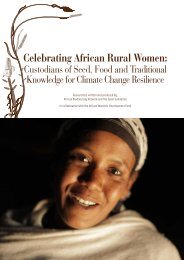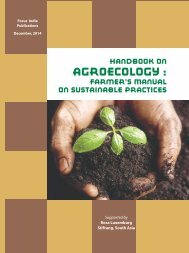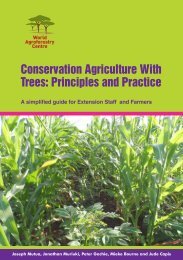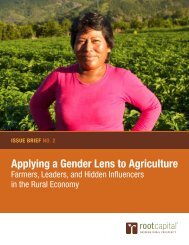1t0SC7l
1t0SC7l
1t0SC7l
You also want an ePaper? Increase the reach of your titles
YUMPU automatically turns print PDFs into web optimized ePapers that Google loves.
Greenland, 1960; Sanchez, 1976; Volkoff et al., 1989; Gerold, 1995). In the study area, the<br />
topsoil structure and porosity changes may be the most important soil degradation characteristics<br />
and the main cause of field plot abandonment and shift.<br />
Results show that presently, the shifting characteristic of the cropping system is defined in two<br />
directions:<br />
- The first direction is that of moving within natural fallow plots of different ages. This<br />
constitutes a rotational system, which is common practice nowadays. It concerns mainly food<br />
crop fields. 76% of the food crop fields in the area rely on this rotational system.<br />
- The second direction is that of agricultural fields expanding into undisturbed forestlands. This<br />
is the traditional pure expansive system, which constitutes more threat to forest conservation<br />
and sustainable management system than the rotational system. This system which concerns<br />
24% of the food crop fields is practised mainly for cucumber (Cucumeropsis mannii)<br />
production and for the establishment of semi-industrial farms by the elite. For this system, an<br />
average of 2200 m² of new forest land is opened per household per year in the TCP area. This<br />
average corresponds to about 300 m² per inhabitant. The Ebimimbang plains and Mvié<br />
uplands have the highest rate of forest encroachment per year and per household with values<br />
of 2450 m² and 2650 m² respectively. The higher rates in these two units are probably<br />
because the land is better accessible for agriculture, leading to an increase in population, and<br />
because the areas have been commercially logged several times (Table 4.2).<br />
Table 4.2. Population variation with landform units in the TCP area<br />
Plains and Uplands of<br />
Ebimimbang and Mvié<br />
Hills and Mountains of<br />
Ebom and Nyangong<br />
Population 1593 992<br />
Household 178 137<br />
4.3.2 Relationship between soil degradation and crop yield<br />
Because of the absence of any significant difference between 0-10 cm and 10-20 cm slices,<br />
results of these analyses are presented for the top 0-20 cm soil layer. The analysis took into<br />
account the two main soil types of the study area. Multiple linear regression coefficients from<br />
these analyses are shown in Table 4.3.<br />
Table 4.3. Multiple linear regression equations of various crop yields as functions of physico-chemical soil<br />
properties in 0-20 cm soil slice (at p








